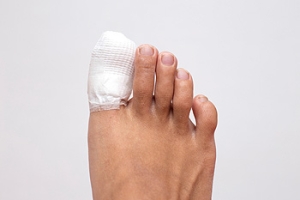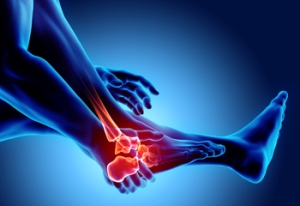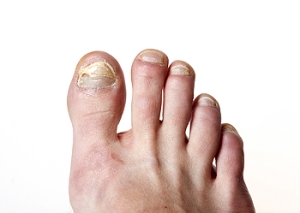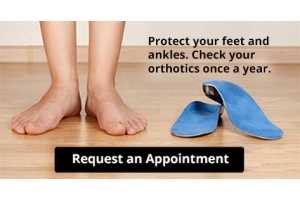
Is Heel Pain a Common Occurrence?
 The calcaneus, or heel bone, and its supporting fat pad, tendons and ligaments bear the brunt of the body’s weight and impact, while absorbing the stress of walking and running. For this reason, it is not uncommon for people of all ages and lifestyles to develop heel pain. Children and adolescents can develop Sever’s Disease when the growth plate of the calcaneus is repeatedly stressed due to growth spurts or physical activity. Plantar fasciitis (inflammation of the tissue on the bottom of the foot from heel-to-toe) and Achilles tendonitis (inflammation of the tendon connecting the calf muscles to the heel bone) can occur at any age, but is most common among adults. Whatever your lifestyle or age, contact a podiatrist if you or someone you love is experiencing any type of heel pain.
The calcaneus, or heel bone, and its supporting fat pad, tendons and ligaments bear the brunt of the body’s weight and impact, while absorbing the stress of walking and running. For this reason, it is not uncommon for people of all ages and lifestyles to develop heel pain. Children and adolescents can develop Sever’s Disease when the growth plate of the calcaneus is repeatedly stressed due to growth spurts or physical activity. Plantar fasciitis (inflammation of the tissue on the bottom of the foot from heel-to-toe) and Achilles tendonitis (inflammation of the tendon connecting the calf muscles to the heel bone) can occur at any age, but is most common among adults. Whatever your lifestyle or age, contact a podiatrist if you or someone you love is experiencing any type of heel pain.
Many people suffer from bouts of heel pain. For more information, contact the foot specialists of Podiatry Associates of Belleville. Our doctors can provide the care you need to keep you pain-free and on your feet.
Causes of Heel Pain
Heel pain is often associated with plantar fasciitis. The plantar fascia is a band of tissues that extends along the bottom of the foot. A rip or tear in this ligament can cause inflammation of the tissue.
Achilles tendonitis is another cause of heel pain. Inflammation of the Achilles tendon will cause pain from fractures and muscle tearing. Lack of flexibility is also another symptom.
Heel spurs are another cause of pain. When the tissues of the plantar fascia undergo a great deal of stress, it can lead to ligament separation from the heel bone, causing heel spurs.
Why Might Heel Pain Occur?
- Wearing ill-fitting shoes
- Wearing non-supportive shoes
- Weight change
- Excessive running
Treatments
Heel pain should be treated as soon as possible for immediate results. Keeping your feet in a stress-free environment will help. If you suffer from Achilles tendonitis or plantar fasciitis, applying ice will reduce the swelling. Stretching before an exercise like running will help the muscles. Using all these tips will help make heel pain a condition of the past.
If you have any questions please contact our office located in Belleville, NJ . We offer the newest diagnostic and treatment technologies for all your foot and ankle needs.
Heel Pain
Heel pain can be difficult to deal with, especially if you do not know what the underlying cause is. If you ignore your heel pain, the pain can magnify and potentially develop into a chronic condition. Depending on the location of your heel pain, you have developed a specific condition.
One condition is plantar fasciitis. Plantar fasciitis is caused by the inflammation of the plantar fascia, or the band of tissue that connects the heel bone to the base of the toes. The pain from this condition is initially mild but can intensify as more steps are taken when you wake up in the morning. To treat this condition, medication will likely be necessary. Plantar fasciitis is often associated with heel spurs; both require rest and special stretching exercises.
There are various options your podiatrist may suggest for heel pain. Treatment options for heel pain typically include non-steroidal anti-inflammatory drugs (NSAIDS), which may reduce swelling and pain. Other options are physical therapy, athletic taping, and orthotics. In severe cases of heel pain, surgery may be required.
Preventing heel pain is possible. If you are looking to prevent heel pain from developing in the future, be sure to wear shoes that fit you properly and do not have worn down heels or soles. Be sure to warm up properly before participating in strenuous activities or sports that place a lot of a stress on the heels. If you are experiencing any form of heel pain, speak with your podiatrist to determine the underlying cause and receive the treatment you need.
Can I Run With a Broken Toe?
 Your toes play a very important role when it comes to movement, especially for runners. Your toes stabilize your foot with each step that you take and help you push off the ground, and your big toes also play a role in stabilizing your arches. If you have broken a toe, you may experience symptoms such as severe bruising, pain, deformity, discoloration, and swelling. Naturally, this can make walking, and even standing, difficult. Running with a broken toe is therefore not suggested. A broken toe can take up to six weeks to heal, depending on the severity of the break, and engaging in high impact exercises like running before the toe is fully healed can lead to pain and further injury. If you have broken your toe, please seek the care of a podiatrist.
Your toes play a very important role when it comes to movement, especially for runners. Your toes stabilize your foot with each step that you take and help you push off the ground, and your big toes also play a role in stabilizing your arches. If you have broken a toe, you may experience symptoms such as severe bruising, pain, deformity, discoloration, and swelling. Naturally, this can make walking, and even standing, difficult. Running with a broken toe is therefore not suggested. A broken toe can take up to six weeks to heal, depending on the severity of the break, and engaging in high impact exercises like running before the toe is fully healed can lead to pain and further injury. If you have broken your toe, please seek the care of a podiatrist.
Broken toes may cause a lot of pain and should be treated as soon as possible. If you have any concerns about your feet, contact the foot specialists from Podiatry Associates of Belleville. Our doctors will treat your foot and ankle needs.
What Is a Broken Toe?
A broken toe occurs when one or more of the toe bones of the foot are broken after an injury. Injuries such as stubbing your toe or dropping a heavy object on it may cause a toe fracture.
Symptoms of a Broken Toe
- Swelling
- Pain (with/without wearing shoes)
- Stiffness
- Nail Injury
Although the injured toe should be monitored daily, it is especially important to have a podiatrist look at your toe if you have severe symptoms. Some of these symptoms include worsening or new pain that is not relieved with medication, sores, redness, or open wounds near the toe.
If you have any questions, please feel free to contact our office located in Belleville, NJ . We offer the newest diagnostic and treatment technologies for all your foot care needs.
Dealing With Rheumatoid Arthritis Flare Ups
 Rheumatoid arthritis (RA) is an autoimmune disorder in which the body’s immune system attacks healthy cells in the joints, causing joint pain, stiffness, inflammation, and degeneration. While RA can affect any part of the body, it frequently affects the small joints of the feet and ankles. During RA flare ups, symptoms of this disease can worsen and impact your ability to participate in activities of daily living. During a flare up, it is suggested that you rest more, if possible, to reduce pain. Doing gentle exercises, such as simple stretches, water exercises, and walking, can help prevent joint stiffness. Applying a hot or cold pack to your joints may help decrease pain and swelling. If you have RA that affects your feet, a podiatrist can assist you in managing this condition.
Rheumatoid arthritis (RA) is an autoimmune disorder in which the body’s immune system attacks healthy cells in the joints, causing joint pain, stiffness, inflammation, and degeneration. While RA can affect any part of the body, it frequently affects the small joints of the feet and ankles. During RA flare ups, symptoms of this disease can worsen and impact your ability to participate in activities of daily living. During a flare up, it is suggested that you rest more, if possible, to reduce pain. Doing gentle exercises, such as simple stretches, water exercises, and walking, can help prevent joint stiffness. Applying a hot or cold pack to your joints may help decrease pain and swelling. If you have RA that affects your feet, a podiatrist can assist you in managing this condition.
Because RA affects more than just your joints, including the joints in your feet and ankles, it is important to seek early diagnosis from your podiatrist if you feel like the pain in your feet might be caused by RA. For more information, contact the foot specialists of Podiatry Associates of Belleville. Our doctors will assist you with all of your podiatric concerns.
What Is Rheumatoid Arthritis?
Rheumatoid Arthritis (RA) is an autoimmune disorder in which the body’s own immune system attacks the membranes surrounding the joints. Inflammation of the lining and eventually the destruction of the joint’s cartilage and bone occur, causing severe pain and immobility.
Rheumatoid Arthritis of the Feet
Although RA usually attacks multiple bones and joints throughout the entire body, almost 90 percent of cases result in pain in the foot or ankle area.
Symptoms
- Swelling and pain in the feet
- Stiffness in the feet
- Pain on the ball or sole of feet
- Joint shift and deformation
Diagnosis
Quick diagnosis of RA in the feet is important so that the podiatrist can treat the area effectively. Your doctor will ask you about your medical history, occupation, and lifestyle to determine the origin of the condition. Rheumatoid Factor tests help to determine if someone is affected by the disease.
If you have any questions please feel free to contact our office located in Belleville, NJ . We offer the newest diagnostic and treatment technologies for all your foot and ankle needs.
What to Do to Keep Your Child’s Feet Healthy
Being a parent involves caring for your child in every way you can. You make sure they are eating the right food, being nice to others, and staying out of any trouble. However, it is also important that you are watchful of their health, more specifically their foot health. Maintaining good foot health in childhood is important in preventing later conditions in life from happening. As children continue to develop, their feet require different techniques of care. Here are some various ways in which you can help your child’s feet stay healthy.
A baby needs a lot of care and attention overall, but the importance of their feet should never be forgotten. Before a baby turns one, their feet change and develop greatly. It is important that during this time, a mother avoids putting tight socks on their child. She should also encourage movement of their feet so the baby can begin to feel more comfortable using them.
As a baby enters the toddler years of his or her life, they are begin to walk around. When your baby begins to take those first steps, it is crucial that they are wearing protective shoes on their feet. As a mother that is observant of your child’s feet, you may notice changes in them. This is completely normal as the feet are becoming susceptible to the activity of walking. It is normal for a toddler to be a bit unsteady or to “walk funny” at first.
When your child grows out of their toddler years, it is important that you begin to show him or her how to care for their feet on their own. Practice with your child proper hygiene in order to prevent foot fungus or infection. Since children are constantly on the move, it is crucial to be cautious of any accidents or injuries that might occur. If an injury occurs, it is advised that you take your child to be examined by a doctor immediately. Since your child is still growing, particular injuries can shift the way in which a bone or other important part of the foot is developing.
Babies and kids are always changing and growing. Your job as a parent is to make sure they stay healthy and making sure they are properly maintained. This involves proper foot care and making sure the feet stay healthy. Following this guide, your child can live a long and happy life.
What to Do to Keep Your Child’s Feet Healthy
Being a parent involves caring for your child in every way you can. You make sure they are eating the right food, being nice to others, and staying out of any trouble. However, it is also important that you are watchful of their health, more specifically their foot health. Maintaining good foot health in childhood is important in preventing later conditions in life from happening. As children continue to develop, their feet require different techniques of care. Here are some various ways in which you can help your child’s feet stay healthy.
A baby needs a lot of care and attention overall, but the importance of their feet should never be forgotten. Before a baby turns one, their feet change and develop greatly. It is important that during this time, a mother avoids putting tight socks on their child. She should also encourage movement of their feet so the baby can begin to feel more comfortable using them.
As a baby enters the toddler years of his or her life, they are begin to walk around. When your baby begins to take those first steps, it is crucial that they are wearing protective shoes on their feet. As a mother that is observant of your child’s feet, you may notice changes in them. This is completely normal as the feet are becoming susceptible to the activity of walking. It is normal for a toddler to be a bit unsteady or to “walk funny” at first.
When your child grows out of their toddler years, it is important that you begin to show him or her how to care for their feet on their own. Practice with your child proper hygiene in order to prevent foot fungus or infection. Since children are constantly on the move, it is crucial to be cautious of any accidents or injuries that might occur. If an injury occurs, it is advised that you take your child to be examined by a doctor immediately. Since your child is still growing, particular injuries can shift the way in which a bone or other important part of the foot is developing.
Babies and kids are always changing and growing. Your job as a parent is to make sure they stay healthy and making sure they are properly maintained. This involves proper foot care and making sure the feet stay healthy. Following this guide, your child can live a long and happy life.
Everything You Need to Know About Gout
Gout, typically found in diabetic patients, is an unusually painful form of arthritis caused by elevated levels of uric acid in the bloodstream. The condition typically strikes the big joint on the big toe. It has also been known to strike the knees, elbows, fingers, ankles and wrists—generally anywhere that has a functioning, moving joint.
The high level of uric acid in a person’s bloodstream creates the condition known as hyperuricema—the main cause of gout. Genetic predisposition occurs in nine out of ten sufferers. The children of parents who suffer gout will have a two in ten chance of developing the condition as well.
This form of arthritis, being particularly painful, is the leftover uric acid crystallizing in the blood stream. The crystallized uric acid then travels to the space between joints where they rub, causing friction when the patient moves. Symptoms include: pain, redness, swelling, and inflammation. Additional side effects may include fatigue and fever, although reports of these effects are very rare. Some patients have reported that pain may intensify when the temperature drops, such as when you sleep.
Most cases of gout are easily diagnosed by a podiatrist’s assessment of the various symptoms. Defined tests can also be performed. A blood test to detect elevated levels of uric acid is often used as well as an x-ray to diagnose visible and chronic gout.
Treatment for gout simply means eliminating symptoms. Non-steroid anti-inflammatory drugs or NSAIDs (Colchicine and other corticosteroid drugs, etc.) will quell the redness, the swelling, and the inflammation. However, managing your diet, lifestyle changes, and using preventative drugs are all helpful toward fully combating the most severe cases.
Those that lead an inactive lifestyle are at a higher risk for gout. Any amount of exercise decreases the probability of repeat encounters with the condition. Reducing your consumption of red meat, sea food, and fructose-sweetened drinks also reduces the likelihood of chronic gout as well.
Ingesting Vitamin C, coffee, and particular dairy products can help with maintaining a healthy lifestyle. There are new drugs out on the market that inhibit the body’s production of uric acid-producing enzymes. However, reducing or eliminating your overall levels of uric acid is the best remedy to ensuring you lead a gout-free life.
Is Toenail Fungus Contagious?
 Fungal infections of the toenails are a common problem, affecting at least 10% of the adult population. One of the reasons that this type of infection may be so common is because it is contagious. Within an individual, fungal infections can spread from one infected nail to another nail, and from infected nails to the surrounding skin. Having poor foot hygiene, wearing old shoes made with unbreathable materials, sharing personal items like pedicure tools or towels, and walking barefoot in public places can put you at a greater risk of contracting toenail fungus. If you notice the symptoms of a fungal infection in your toenails, such as the nails thickening, changing shape or texture, or becoming discolored, please see a podiatrist for treatment.
Fungal infections of the toenails are a common problem, affecting at least 10% of the adult population. One of the reasons that this type of infection may be so common is because it is contagious. Within an individual, fungal infections can spread from one infected nail to another nail, and from infected nails to the surrounding skin. Having poor foot hygiene, wearing old shoes made with unbreathable materials, sharing personal items like pedicure tools or towels, and walking barefoot in public places can put you at a greater risk of contracting toenail fungus. If you notice the symptoms of a fungal infection in your toenails, such as the nails thickening, changing shape or texture, or becoming discolored, please see a podiatrist for treatment.
For more information about treatment, contact the foot specialists of Podiatry Associates of Belleville. Our doctors can provide the care you need to keep you pain-free and on your feet.
Toenail Fungus Treatment
Toenail fungus is a condition that affects many people and can be especially hard to get rid of. Fortunately, there are several methods to go about treating and avoiding it.
Antifungals & Deterrence
Oral antifungal medicine has been shown to be effective in many cases. It is important to consult with a podiatrist to determine the proper regiment for you, or potentially explore other options.
Applying foot powder on the feet and shoes helps keep the feet free of moisture and sweat.
Sandals or open toed shoes – Wearing these will allow air movement and help keep feet dry. They also expose your feet to light, which fungus cannot tolerate. Socks with moisture wicking material also help as well.
If you have any questions please feel free to contact our office located in Belleville, NJ . We offer the newest diagnostic tools and technology to treat your foot and ankle needs.
Toenail Fungus
Toenail fungus is a frustrating problem that affects many people. It can be persistent and hard to get rid of. As many different types of fungi are present throughout the environment, it is very easy to contract toenail fungus.
The feet are especially susceptible to toenail fungus because shoes and socks create the ideal dark and moist environment that fungal infections thrive in. While fungal infections of the nail plate are quite common, if left untreated they can spread beyond the toenail and into the skin and other parts of the body.
Signs of toenail fungus include a thickened nail that has become yellow or brown in color, a foul smell, and debris beneath the nail. The toe may become painful due to the pressure of a thicker nail or the buildup of debris.
Treatment for toenail fungus is most effective during the early stages of an infection. If there is an accumulation of debris beneath the nail plate, an ingrown nail or a more serious infection can occur. While each treatment varies between patients, your podiatrist may prescribe you oral medications, topical liquids and creams, or laser therapy. To determine the best treatment process for you, be sure to visit your podiatrist at the first signs of toenail fungus.





